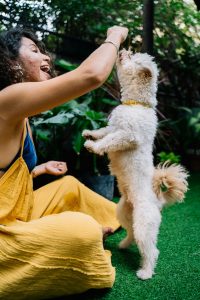No matter if you are an experienced owner, or you are just entering the world of puppies, sit is the basic command you need to teach your dog.
When you start the training of your dog, the first thing you need to do is teach him how to sit on command.
Why? Because all other commands are linked with sit. They either start with sit or end up in sit. So, the question now is how to train your dog to sit.
Benefits of positive reinforcement
Before we get to the guide of how to train your dog to sit, let’s talk about the method you want to use. That is positive reinforcement. In the past several years, positive reinforcement has been deemed the de facto best way to train your dog.
It is the foundation of dog training. Positive reinforcement is a process in which you give your dog a reward to encourage the behavior you want.
Think of it as a paycheck for going to work. Since dogs do not go to work, you reward them for their positive behavior. In the same time, you want to avoid punishment like yelling and leash correction.
You can use anything you like for positive reinforcement. It is all about what your dog likes. For example, you can do positive reinforcement training with toys your dog likes, or with treats.
Most people and trainers go for small treats or pieces of high-value food for training sessions. You can even use your dog’s kibble for training.
Puppies can begin simple training and commands like sit as soon as they come home, which is usually at 8 weeks old. Keep training sessions brief, between 5 and 10 minutes. You also need to remember that dogs learn best when they are happy and tired.
If your dog just woke up, he is still lazy, has not been active for a while, and he will not listen to commands. Make sure to end the training session on a positive note, with a command, action, or behavior your dog knows.
The benefits of positive reinforcement are:
- Character development
- Increased motivation to perform well
- Motivation to exceed expectations
- Feeling good about themselves
- Discovering their motivation
What is the proper sit position?
Before you start training sessions for how to train your dog to sit, you need to know the proper sit position. If your dog is not in the correct sit position, you should not reward him.
Instead, you should help your dog by either moving or positioning him in the correct position and then reward him.
The correct sit position is with the hocks and bottom firmly planted on the ground. Some dogs might cheat and hover above the ground, so be sure not to reward your dog until his/her rear is on the ground.
Ideally, your dog should stay in the sit position until you release him either by command, or giving him a treat, and telling the job is done.
Guide to Sit Command
As mentioned previously, the best way for how to train your dog to sit is to use positive reinforcement. This is a guide for using the treat trick for sitting.
Here is a step by step guide.
- Get small treats you will give to your dog
- The first step is to capture your dog’s attention. Stand directly in front of your dog, with him facing you. This way, your dog is completely focused on you, and he can see and hear you clearly
- Show your dog the treat, which should be something he likes. Hold the treat in your hand, so that your dog knows you have it. But at the same time, keep it at a distance so he cannot grab it from you. At this point, you have your dog’s full attention
- Keep the treat close to your dog’s nose, allowing him to sniff it so that he knows it is something of value. Slowly raise the treat over the top of his head. As your dog follows the treat with his nose and eyes, he will look upward. In the process, he will naturally place his bottom on the ground
- Make sure the treat is close to his head, so that he won’t try to jump up to get it, but low enough so that he will sit. If your dog’s bottom is not fully on the ground, gently ease him into a full sit and correct sit position
- Give your dog the command sit, and then reward him with a treat. Say “sit” with a firm voice, at the moment your dog makes contact with the ground
- Give your dog the treat, and praise his good behavior. You can rub his head, pet him, or use words like “good job”, “good boy” and so on
- You can then release your dog from the sit position. Use “release” or “free”, or just take a step back and encourage him to come to you
What if treats do not work?
Very active dogs might sometimes require more training. In some cases, the treat trick might not work, and you need physical guidance. With physical guidance, you have better control over your rambunctious dog.
- Put your dog on a leash, as you need him to stay in place and have his attention. Hold the leash taut, so that your dog is close to you. But the leash should not be too tight. If it makes your dog uncomfortable, he will not listen
- Stand next to your dog, and encourage him to sit. You can help your dog lower from the standing position by gently pushing the area above his rear legs. Your dog might be confused at first, but he will pick it up quickly
- Remember, do not force your dog into a sit position. He might take it as a punishment, and it can scare him. Do not spank or hit your dog
- If your dog refuses to sit, walk him around on the leash to reset the sit session, and then try to ease him into a sit position again
- As your dog’s bottom touches the floor, say the “sit command”. Gently pet your dog to encourage good behavior
- Repeat the process several times, and always praise your dog for successful sit
- Once your dog handles sit with assistance, try an unassisted sit command. With your dog on a leash, say “sit” when your dog is standing without using your hand on his rear legs. Reward and praise him if he succeeds
Tips for success
Sit is the basic command for dog training. Everything else goes from there. With that in mind, we gave you two techniques for how to train your dog to sit. But we also want to give you a few more pointers, tips, and tricks for success.
- Be patient, and take it slowly. Puppies have a limited attention span, and they can be easily distracted
- Give your dog breaks from training to get him to fully focus once you give commands
- Practice training sessions in an area your dog is comfortable with
- If there are people in the house, tell them not to distract the dog while training sessions
- Training sessions are best done after a playtime. After playing, your dog is happy, and he is more willing to listen to your commands and be obedient








2 Responses
its awsome it helped me a lot
Happy to help buddy